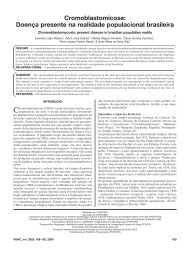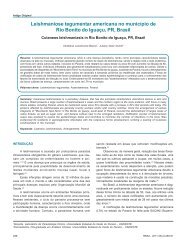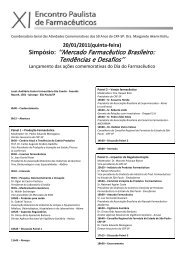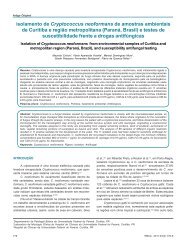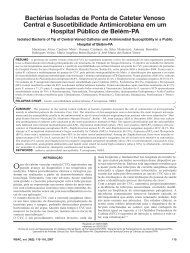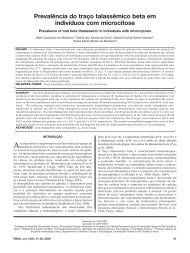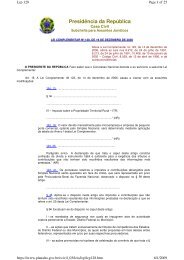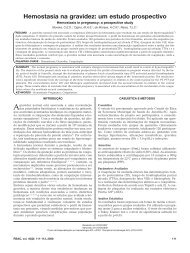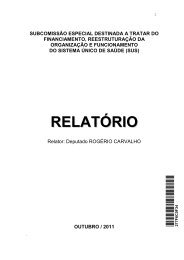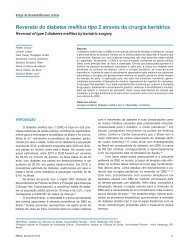Clinica Chimica Acta
Clinica Chimica Acta
Clinica Chimica Acta
You also want an ePaper? Increase the reach of your titles
YUMPU automatically turns print PDFs into web optimized ePapers that Google loves.
2 Letter to the editor<br />
Table 1<br />
Effects of tourniquet application vs. transilluminator device in blood sample collection on coagulation parameters.<br />
G1 (N=50)<br />
G2 (N=50)<br />
Desirable<br />
bias (%)<br />
Mean value±SD<br />
of transilluminator<br />
Mean value±SD<br />
of 30 s tourniquet<br />
p-Value Mean %<br />
difference<br />
Mean value±SD<br />
of transilluminator<br />
Mean value±SD<br />
of 90 s tourniquet<br />
p-Value Mean %<br />
difference<br />
FIB (mg/dl) 4.8 384.9±94.9<br />
[240.0–604.8]<br />
PT (s) 2.0 12.32±3.20<br />
[10.30–14.21]<br />
APTT (s) 2.3 29.86±4.28<br />
[22.50–33.80]<br />
385.1±94.9<br />
[240.0–605.0]<br />
12.30±3.23<br />
[10.31–14.19]<br />
29.80±4.30<br />
[22.50–33.77]<br />
N0.05 0.05 358±72<br />
[190–512]<br />
N0.05 −0.2 14.47±7.94<br />
[10.9–38.9]<br />
N0.05 −0.2 31.80±7.90<br />
[25.8–36.7]<br />
364±72<br />
[199–525]<br />
14.41 ±8.00<br />
[10.8–37.4]<br />
31.70 ±7.80<br />
[25.3–35.1]<br />
0.002 1.7 ⁎<br />
N0.05 −0.4<br />
N0.05 −0.3<br />
Desirable<br />
bias (%)<br />
G3 (N=50)<br />
Mean value±SD<br />
of transilluminator<br />
FIB (mg/dl) 4.8 288±89<br />
[173–540]<br />
PT (s) 2.0 12.89±1.61<br />
[11.0–18.4]<br />
APTT (s) 2.3 31.70±4.50<br />
[24.1–44.3]<br />
Mean value±SD<br />
of 120 s tourniquet<br />
296±93<br />
[189–545]<br />
12.67±1.57<br />
[10.9–18.0]<br />
31.20±4.40<br />
[20.1–38.7]<br />
p-Value Mean %<br />
difference<br />
G4 (N=50)<br />
Mean value±SD<br />
of transilluminator<br />
0.001 3.0 ⁎⁎ 361±85<br />
[218–495]<br />
0.003 −1.7 ⁎⁎ 12.65±3.29<br />
[11.0–15.1]<br />
0.009 −1.5 ⁎⁎ 30.20±4.40<br />
[22.5–42.3]<br />
Mean value±SD<br />
of 180 s tourniquet<br />
385±95<br />
[240–605]<br />
12.30 ±3.23<br />
[8.7–14.2]<br />
29.80 ±4.30<br />
[22.5–22.8]<br />
p-Value Mean %<br />
difference<br />
0.001 6.7 ⁎⁎<br />
0.001 −2.8 ⁎⁎<br />
0.002 −1.4 ⁎⁎<br />
The values were mean ±SD [range: minimum–maximum]. The bold p-values are statistically significant (pb0.05) and bold mean % differences represent clinically significant<br />
variations, when compared with desirable bias [38].<br />
⁎ pb0.05 vs. G1.<br />
⁎⁎ pb0.05 vs. G1 and G2.<br />
The results of this investigation are shown in Table 1. InG1no<br />
significant increases were observed in coagulation parameters<br />
evaluated after 30 s of the tourniquet application. In G2, after 90 s of<br />
the tourniquet application, a significant increase was observed in<br />
fibrinogen. In G3, significant increases in FIB, PT and APTT were<br />
observed after 120 s of the tourniquet application. In G4 significant<br />
increases were observed in all coagulation tests evaluated after 180 s<br />
of the tourniquet application. However, a clinically significant variation,<br />
as compared with the current desirable quality specifications<br />
[38], was only observed for fibrinogen and PT after 3 min of stasis<br />
(G4).<br />
Our results demonstrate that the prolonged stasis consequent on<br />
tourniquet application for 120 s causes significant reduction of PT and<br />
APTT values in both tests (Table 1), a well known phenomenon of in<br />
vitro activation, thus paving the way for possible errors in critical<br />
patient management and follow-up. As reported, rarely the expert<br />
phlebotomist concludes the collection of diagnostic blood specimens<br />
within 60 s of tourniquet application [18]. Several concurrent causes<br />
might contribute to lengthen the tourniquet time even over 3 min,<br />
such as a difficult location of an appropriate venous access, selection<br />
of the most suited blood collection system, needle insertion into the<br />
vein, collection of many tubes, etc. [3,5,6,9,15–17]. As regards<br />
fibrinogen, the significant increase observed in groups G2, G3, and<br />
G4 appears on overall modest and could be considered not clinically<br />
significant. Nevertheless, even modest increases of fibrinogen, a<br />
marker of inflammation, have been associated with future coronary<br />
heart disease and with unstable and stable coronary artery disease<br />
and coronary complications after interventions [39]. Thus the use of<br />
tourniquet could generate false positives and prospectively induce the<br />
caring physicians to adopt undue treatments. On the contrary,<br />
transillumination devices appear able to eliminate such risk [40]. In<br />
order to deal with some of the above issues, the quality laboratory<br />
manager might devise and adopt improved blood collection procedures<br />
with no or very reduced tourniquet times, e.g., by implementing<br />
transillumination devices after accurate re-evaluation of the<br />
whole blood collection procedures employed by phlebotomist [7].<br />
Obviously such a process of change of blood collection procedures<br />
should be supported by adequate practical instructions provided by<br />
expert professionals. In conclusion, the results we obtained demonstrate<br />
that by employing the recommended procedure of tourniquet<br />
application with gold standard time (30 s) [10–12] in blood collection,<br />
the performance of the coagulation routine testing is identical to that<br />
shown by blood collected with the aid of transillumination. Probably<br />
the errors induced by venous stasis on specialized coagulation tests<br />
like D-dimer, Factors VII, VIII and XII [17] would be eliminated too<br />
using the transillumination. Further insight has to be made in this<br />
respect. Moreover, the whole results demonstrate that transillumination<br />
devices can eliminate the venous stasis and improve the<br />
quality process in preanalytical phase especially in phlebotomy<br />
procedures, mostly when considering that inappropriately prolonged<br />
tourniquet application is rather widespread and no common rules<br />
and/or guidelines appear applied in this respect. These results do<br />
apply to our experimental design, even though they represent a viable<br />
basis for the governance of the preanalytical variability related to<br />
sample stasis.<br />
No potential conflicts of interest relevant to this article were<br />
reported.<br />
References<br />
[1] Wallin O, Soderberg J, Van Guelpen B, Stenlund H, Grankvist K, Brulin C.<br />
Preanalytical venous blood sampling practices demand improvement—a survey of<br />
test-request management, test-tube labelling and information search procedures.<br />
Clin Chim <strong>Acta</strong> 2008;391:91–7.<br />
[2] Lippi G, Bassi A, Brocco G, Montagnana M, Salvagno GL, Guidi GC. Preanalytic error<br />
tracking in a laboratory medicine department: results of a 1-year experience. Clin<br />
Chem 2006;52:1442–3.<br />
[3] Carraro P, Plebani M. Errors in a stat laboratory: types and frequencies 10 years<br />
later. Clin Chem 2007;53:1338–42.<br />
[4] Plebani M, Carraro P. Mistakes in a stat laboratory: types and frequency. Clin Chem<br />
1997;43:1348–51.<br />
[5] Lippi G, Fostini R, Guidi GC. Quality improvement in laboratory medicine: extraanalytical<br />
issues. Clin Lab Med 2008;28:285–294, vii.<br />
[6] Lippi G, Guidi GC. Risk management in the preanalytical phase of laboratory<br />
testing. Clin Chem Lab Med 2007;45:720–7.<br />
[7] Lima-Oliveira G, Picheth G, Sumita NM, Scartezini M. Quality control in the<br />
collection of diagnostic blood specimens: illuminating a dark phase of preanalytical<br />
errors. J Bras Patol Med Lab 2009;45:441–7.<br />
[8] Lippi G, Guidi GC. Preanalytic indicators of laboratory performances and quality<br />
improvement of laboratory testing. Clin Lab 2006;52:457–62.<br />
[9] Lippi G, Salvagno GL, Montagnana M, Franchini M, Guidi GC. Phlebotomy issues<br />
and quality improvement in results of laboratory testing. Clin Lab 2006;52:<br />
217–30.<br />
[10] CLSI, Procedures for the collection of diagnostic blood specimens by venipuncture.<br />
NCCLS H3-A6. 2007.<br />
[11] CLSI, Procedures for the handling and processing of blood specimens for common<br />
laboratory tests. NCCLS H18-A4., 2010.<br />
[12] CLSI, Collection, Transport, and processing of blood specimens for testing plasmabased<br />
coagulation assays and molecular hemostasis assays. NCCLS H21-A5., 2008.<br />
Please cite this article as: Lima-Oliveira G, et al, Elimination of the venous stasis error for routine coagulation testing by transillumination,<br />
Clin Chim <strong>Acta</strong> (2011), doi:10.1016/j.cca.2011.04.008



